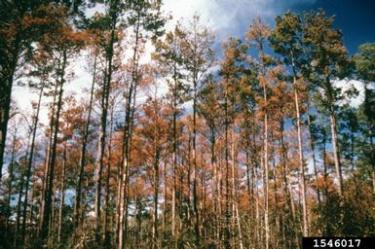When Southern Pine Beetles Attack
In some parts of the country, the southern pine beetle’s toll is easy to see: whole ridgelines turn bright reddish brown as pine trees die.
But the culprit is harder to spot. Ips engraver beetles and turpentine beetles are also common in the South, and they’re also very small and difficult to identify in the field. So how can you know if your trees are under southern pine beetle attack?
What does an SPB infestation do to my trees?
When a female southern pine beetle is ready to feed and lay eggs, she chooses a host tree and starts chewing her way inside. But she isn’t alone: a burrowing beetle will release pheromones that attract other southern pine beetles to the tree and its surroundings.
The tree also becomes home to mites, bluestain fungus and mycangial fungus, which piggyback on the beetles as they bore their way in. Once inside, the beetles carve out S-shaped “galleries” where females lay their eggs and where young beetles grow.
Together, the fungal infections and the beetles’ burrowing and feeding kill the tree.
Healthy trees fight back, oozing resin to flush out the attacking beetles. But when thousands attack all at once, experts say it’s only a matter of time before trees die and the infestation spreads.
The process leaves these tell-tale signs:
- Unique mortality patterns. If the southern pine beetle is to blame, trees will typically die in a directional pattern, progressing out from the epicenter of the attack. With other pine bark beetles, trees typically die in a patchy or scattered pattern.
- Pitch tubes. As the tree oozes resin to “pitch out” attacking beetles, that resin will dry into white or reddish popcorn-sized globs visible on the tree’s trunk. These are a good indicator of infestation.
- S-shaped galleries. Look just beneath the tree’s bark and you’ll find the southern pine beetle’s winding, S-shaped chambers for laying eggs. The shape is unique to the southern pine beetle. Ips engraver beetles make H-, Y- or I-shaped galleries, and turpentine beetles make wider galleries close to the ground.
- Helpful friends. Checkered beetles prey on southern pine beetles, so if you spot them on your trees, you may have an SPB infestation.
I’ve got southern pine beetles. Now what?
If the signs point to an SPB infestation, you can still control the damage. Taking action immediately can save the rest of your forest.
Learn More
Interested in some of the latest research on bark beetles? Then be sure to check out what some of these researchers are working on:
- Matt Ayres, Professor of Biological Sciences at Dartmouth College
- John, Nowak, Entomologist, Southern Pine Beetle Prevention Restoration Coordinator for the US Forest Service
- Mark Vodak, Specialist in Forestry for the New Jersey Agricultural Experiment Station at Rutgers, The State University of New Jersey
How can I get more tips?
It’s simple! Enter your email below.

